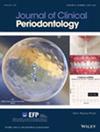Host Markers of Periodontal Diseases: Meta‐Analysis of Diagnostic Accuracy Studies
IF 5.8
1区 医学
Q1 DENTISTRY, ORAL SURGERY & MEDICINE
引用次数: 0
Abstract
ObjectiveTo identify host markers with optimal diagnostic performance for clinical implementation in the diagnosis of periodontal diseases and prediction of future disease progression and/or disease resolution.Material and MethodsCross‐sectional and prospective studies with ≥ 20 participants per group, reporting diagnostic accuracy (e.g., area under the curve [AUC]) of host markers for periodontal diagnosis (focused question 1 [FQ1]), periodontitis progression/relapse (FQ2) or resolution (FQ3) were searched in three electronic databases. Meta‐analyses estimating diagnostic accuracy (DA) for individual host markers and for grouped salivary and gingival crevicular fluid (GCF) markers independently were performed whenever two or more studies were identified.ResultsSixty‐one eligible studies were identified, of which 13 were included in meta‐analyses for FQ1 (discrimination between health and periodontitis). Matrix metalloproteinase‐8 (MMP‐8) was the most reported biomarker in both saliva and GCF, with comparable AUC (0.70–0.90), sensitivity (0.49–0.84) and specificity (0.62–0.79) in both sample types. Cytokines had good ability for discrimination of periodontitis/gingivitis versus health, although they were substantially less accurate for periodontitis versus gingivitis. Combinations of cytokines and MMPs tended to increase overall diagnostic accuracy but without significant improvement in the case of periodontitis/gingivitis discrimination. Bone markers were the best performing group of salivary markers (AUC = 0.91) when compared to cytokines (AUC = 0.86) and MMPs (AUC = 0.77). GCF microRNAs (MiRs) were a singly meta‐analysed group of biomarkers demonstrating AUC = 0.79.ConclusionReported studies on host periodontal markers exhibit serious limitations regarding clinical and validation standards, being the main cause for lack of progress in clinical implementation of biomarkers in periodontal classification. Disease‐specific markers such as bone markers showed better diagnostic performance (from limited number of studies) for the diagnosis of periodontitis when compared to cytokines and MMPs.牙周病的宿主标记物:诊断准确性研究的元分析
目的寻找具有最佳诊断性能的宿主标志物,用于牙周病的临床诊断和预测未来疾病进展和/或疾病消退。材料和方法在三个电子数据库中检索每组≥20名参与者的横断面和前瞻性研究,报告牙周诊断(重点问题1 [FQ1])、牙周炎进展/复发(FQ2)或消退(FQ3)的宿主标志物的诊断准确性(例如曲线下面积[AUC])。每当确定两个或更多的研究时,就进行估计单个宿主标记物和分组唾液和牙龈沟液(GCF)标记物的诊断准确性(DA)的Meta分析。结果共纳入61项符合条件的研究,其中13项纳入了FQ1(健康与牙周炎之间的区别)的meta分析。基质金属蛋白酶8 (Matrix metalloproteinase‐8,MMP‐8)是唾液和GCF中报道最多的生物标志物,在两种样品类型中具有相当的AUC(0.70-0.90)、敏感性(0.49-0.84)和特异性(0.62-0.79)。细胞因子在区分牙周炎/牙龈炎与健康方面具有良好的能力,尽管它们在牙周炎和牙龈炎方面的准确性较低。细胞因子和MMPs的组合倾向于提高整体诊断的准确性,但在牙周炎/牙龈炎的情况下没有显著的改善。与细胞因子(AUC = 0.86)和MMPs (AUC = 0.77)相比,骨标记物是表现最好的唾液标记物组(AUC = 0.91)。GCF microRNAs (MiRs)是一组单一荟萃分析的生物标志物,其AUC = 0.79。结论已有的宿主牙周标志物的研究在临床和验证标准上存在严重的局限性,这是导致生物标志物在牙周分类中的临床应用缺乏进展的主要原因。与细胞因子和MMPs相比,疾病特异性标志物(如骨标志物)在诊断牙周炎方面表现出更好的诊断性能(来自有限数量的研究)。
本文章由计算机程序翻译,如有差异,请以英文原文为准。
求助全文
约1分钟内获得全文
求助全文
来源期刊

Journal of Clinical Periodontology
医学-牙科与口腔外科
CiteScore
13.30
自引率
10.40%
发文量
175
审稿时长
3-8 weeks
期刊介绍:
Journal of Clinical Periodontology was founded by the British, Dutch, French, German, Scandinavian, and Swiss Societies of Periodontology.
The aim of the Journal of Clinical Periodontology is to provide the platform for exchange of scientific and clinical progress in the field of Periodontology and allied disciplines, and to do so at the highest possible level. The Journal also aims to facilitate the application of new scientific knowledge to the daily practice of the concerned disciplines and addresses both practicing clinicians and academics. The Journal is the official publication of the European Federation of Periodontology but wishes to retain its international scope.
The Journal publishes original contributions of high scientific merit in the fields of periodontology and implant dentistry. Its scope encompasses the physiology and pathology of the periodontium, the tissue integration of dental implants, the biology and the modulation of periodontal and alveolar bone healing and regeneration, diagnosis, epidemiology, prevention and therapy of periodontal disease, the clinical aspects of tooth replacement with dental implants, and the comprehensive rehabilitation of the periodontal patient. Review articles by experts on new developments in basic and applied periodontal science and associated dental disciplines, advances in periodontal or implant techniques and procedures, and case reports which illustrate important new information are also welcome.
 求助内容:
求助内容: 应助结果提醒方式:
应助结果提醒方式:


